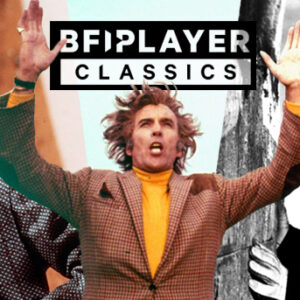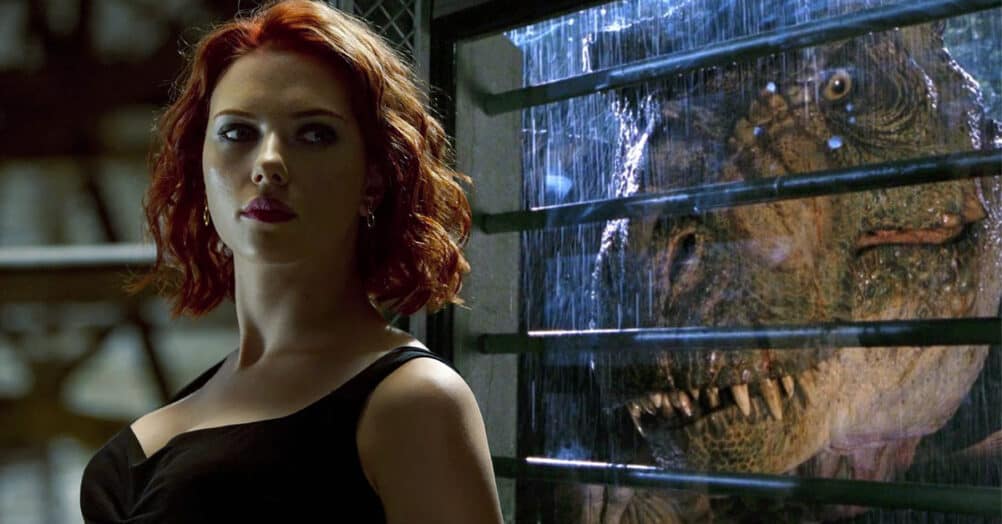Last Updated on August 2, 2021

Welcome to The Best Movie You NEVER Saw, a column dedicated to examining films that have flown under the radar or gained traction throughout the years, earning them a place as a cult classic or underrated gem that was either before it’s time and/or has aged like a fine wine.
This week we’ll be looking at THE THIRD MAN.

THE STORY: Moderately successful pulp novelist Holly Martins journeys to post-war Vienna on the promise of a job from his old friend Harry Lime. When he arrives to find Harry dead and accused of black market profiteering, Holly joins with Harry's mistress Anna to uncover the truth.
THE PLAYERS: writer Graham Green. Director Carol Reed (NIGHT TRAIN TO MUNICH, OLIVER!). Producer David O. Selznick (GONE WITH THE WIND, REBECCA, A STAR IS BORN). Cinematographer Robert Krasker (BILLY BUDD, EL CID). Composer/performer Anton Karas. Actors Joseph Cotton (CITIZEN KANE, SHADOW OF A DOUBT), Alida Valli (1900, SUSPIRIA), Trevor Howard (BRIEF ENCOUNTER, SUPERMAN), and Orson Welles.
THE HISTORY: Before 1949, Graham Greene was already a well-renowned novelist who had seen many of his works adapted for the screen. But it wasn't until a Hungarian producer named Alexander Korda had the idea to make a film in Vienna – the control of which was at the time split between several Allied powers – that Greene was tapped to write what would eventually become THE THIRD MAN. In the beginning all he had was a single sentence of an idea, but Korda loved everything it implied set Green to work on a novella that would allow him to flesh out characters and relationships before writing the script proper. Through 1948 he visited Vienna, both alone and with director Carol Reed, to research and write.
David O. Selznick was approached in order to bring American financing onboard, and a trade was made where Selznick would have the rights to oversee the release future films produced by Korda in the United in exchange for funds and the ability to cast from the pool of stars he had under contract. Selznick was quite a strong personality and in August 1948 expounded onpages and pages of notes for Greene and Reed in a series of late night meetings, but for the most part the writer and director were able to preserve the original vision of the film they'd worked out together earlier that year. Location shooting lasted for six weeks in the fall and winter of 1948 with studio work continued through March of 1949, and the film saw UK release in September of that same year.
"The Third Man Theme" portion of the zither score by Anton Karas – a musician found by Reed one night out in Vienna – went on to top International Music Charts in 1950, while the film itself was awarded the Grand Prix at the 1949 Cannes Film Festival and an Oscar for Best Black and White Cinematography in 1950.

I had paid my last farewell to Harry a week ago, when his coffin was lowered into the frozen February ground, so that it was with incredulity I saw him pass by, without a sign of recognition, among the host of strangers in the Strand. – The one sentence pitch delivered by Greene to Korda
WHY IT'S GREAT: In September 1945, the second world-wide war in a thirty years came to an official end. It was a strange time to be a citizen of the world, with borders redrawn, unnamed bodies filling bombed-out fields, economies wrecked, political idealism in pieces, and the patriotism of many in tatters. Two cities and their populations had been wiped from the earth in a skin-disintegrating flash of impossible light. For many it must have been like waking from a nightmare, if they woke at all, with the world that swiftly shifted in to focus one which they were no longer at all sure they recognized. As the smoke and ash began to clear in the years following the war, some accepted what they saw while others refused. To the second group the horrors were done, the darkness was gone, and the good guys had won. End of story.
Or the start of a new one. Within four years, THE THIRD MAN had been researched, written as a novelette, written as a script, cast, shot, edited, and released. It was filmed and took place in immediately post-war Vienna, when the city was still carved up between the four primary Allied powers – France, Russia, the United States, and the United Kingdom, with a sewer and tunnel network that ran beneath them all. Black market operators thrived on the needs of the suffering and the greed of those willing to take advantage of that suffering, in a city that for the next fifty years would refuse to educate its citizens about anything relating to the war or Austria's place in it beyond “the camps were bad and they’re closed now.”

I shot most of the film with a wide-angle lens that distorted the buildings and emphasized the wet cobblestone streets (it cost a good deal to hose them down constantly)… But the angle of vision was just to suggest that something crooked was going on, I don't think it's a very good idea. I haven't used it much since—only when I need to shoot someone standing behind another person who’s sitting and I don’t want to cut off his head. – Carol Reed
Enter Holly Martins, pulp Western novelist and naïve friend on a journey to the new Old World with no clue that his life is about to become a story more pulpy than he could have ever dreamed. And, as life and reality were after the war, so much more complicated. A mystery awaits him in this fractured place, one his earnest loyalty can’t help but drive him to explore and with a woman he can’t help but try to save. Except the truth of her is that she doesn’t need his saving, and the truth of the mystery is one which forces him to face the new reality he and others like him couldn’t accept after war’s end. Joseph Cotton plays Martins as a classic American man of the time, ready to defend freedom and friendship, sure he’s in the right. It wasn’t until over a year after the bombs were dropped on Hiroshima and Nagasaki that the American people knew anything about the devastation they’d wrought, when The New Yorker published a piece by John Hersey about his visits to those places complete with photos. Holly won’t accept what his friend is accused of, can’t accept that someone he trusted – someone he’s looked up to – could do something so terrible as to steal penicillin meant for sick children and sell it for profit. He can't accept he's been fooled and taken advantage of. And he doesn't know what to do if it's true.
If the best and most enduring films are ones which work on multiple levels at once, resonating from surface to center, then THE THIRD MAN’s classic status nearly seventy years on in this young medium we love so much is no mystery. While far from popular on its initial release – everything from content to form was criticized, with the inventive and (at the time) revolutionary camera work being particularly called out – its cinematography and corruptions of idealism and morality helped to herald the birth of a new kind of cinematic storytelling. For students of directing, cinematography, acting, script writing, production design, the film is rock solid and an essential piece to study for the interplay between all of these as they work inextricably together to spin the most tightly-knit of narratives with thematic echoes from the first scene's set-up of Holly's purpose all the way through to the choreography of the final chase.
This is all done so well, in fact, that THE THIRD MAN isn't just rock solid – it's a diamond. One Harry Lime himself would likely sell his best friend, lover, and adopted city for.

I suffered a lot of opposition going to Vienna with The Third Man. In those days, one didn't take actors on location. But here's an example of the way finance does dominate the business. If you've got five weeks on location, you know you've got to get all your shots in that period. We had a day and a night unit. The actors we used at night didn't work in the day and vice versa. We worked from eight p.m. to five a.m. then went .to bed, got up at ten a.m. worked with the day unit until four, and then went back to bed until eight. That way we got double the work done in the same time. It's a bit of a rush, but it's better to rush than not get it all and have to match things in the studio. – Carol Reed
More than that though this film is a portrait of a very particular time and place, almost to the point of being a documentary that also happens to have a superb story and cast of characters driving its action. War – and war films – are so often about speeches and atrocities, battles and more battles, triumphant escapes and heroic dogfights. This is about the cost of conflict on the small people, in THE THIRD MAN's case people who either stayed home and safe or stayed home in fear as a hellish storm broke over them. Through meticulously-wrought fiction, naturalistic performances, and striking direction it handles historical truths that were denied then and are often still ignored now, and in doing so manages to beautifully bridge that all-too-dangerous gap between "important" and "entertaining."
Few creative mediums have changed faster than film (video games arguably take that honor), and it can be difficult at times to step back into the style and sensibilities of certain eras. Acting, staging, dialogue, and score decisions can all grate on how our intrinsic understanding of storytelling itself has shifted in response to new forms. But somehow THE THIRD MAN continues to live a life unshackled by the potential pitfalls of its era, the production elements cohering with script and truth to produce something that continues to transcend time and place to inhabit a classic space all its own. This is one of the essentials.

The themes of the picture made me feel comfortable about dealing with similar kinds of characters, characters you'd consider undesirable – the charm of evil. I did a paper on the film when I was 18 at NYU. The professor had different ideas. He wrote a note on the paper: 'Remember, it's only a thriller.' I disagreed. We know what happens in Psycho or Vertigo or The Red Shoes. So why do we keep watching? If some dismiss a work because it 'fits' into a genre, then why does it sustain repeated viewings? It's more than the plot twists and surprises of the story. Certainly, it's the characters, the world they inhabit, the love stories, the trust and betrayals – the human heart. Each presented with intelligence, wit, and a very real joy of film-making, while still feeling fresh. – Martin Scorsese
BEST SCENE:
"When the picture came out, the Swiss very nicely pointed out to me that they've never made any cuckoo clocks" revealed Orson Welles about what is perhaps the most famous speech from the film, not to mention one of its best. Welles is credited for the speech itself, inserted into the film's action for pacing, but doubt and debate have swirled around how much was truly his invention versus his re-interpretation of another speech from another source. Whatever the case, whatever the truth, it doesn't change how the scene below – the first time in the flim Holly is able to speak to his old friend Harry face to face – not only pays off a film's worth of buildup but also crystalizes the damaging dangers of the post-war situation and changes everything for the characters irrevocably.
SEE IT: You can buy THE THIRD MAN on Blu-Ray + DVD HERE!
PARTING SHOTS:
One of the very few major disputes between Carol Reed and myself concerned the ending, and he has been proved triumphantly right. – Graham Greene (who originally fought for the ending as seen in his novella, which was much happier in tone)


















Follow the JOBLO MOVIE NETWORK
Follow us on YOUTUBE
Follow ARROW IN THE HEAD
Follow AITH on YOUTUBE